2021 TOYOTA YARIS CROSS light
[x] Cancel search: lightPage 167 of 650

165
3
YARIS CROSS Owner's Manual_Europe_M52K60_en
3-4. Adjusting the steering wheel and mirrors
Before driving
The height of the rear view mirror
can be adjusted to suit your driving
posture.
Adjust the height of the rear view
mirror by moving it up and down.
Manual anti-glare inside rear
view mirror
Reflected light from the headlights
of vehicles behind can be reduced
by operating the lever.
1 Normal position
2 Anti-glare position
Auto anti-glare inside rear view
mirror
Responding to the level of bright-
ness of the headlights of vehicles
behind, the reflected light is auto-
matically reduced.
Changing automatic anti-glare
function mode on/off
When the automatic anti-glare function
is in ON mode, the indicator illumi-
nates. The function will set to ON mode
each time the power switch is turned to
ON.
Pressing the button turns the function
to off mode. (The indicator also
turns off.)
Inside rear view mirror
The rear view mirror’s position
can be adjusted to enable suf-
ficient confirmation of the rear
view.
Adjusting the height of rear
view mirror
WARNING
■Caution while driving
Do not adjust the position of the mir-
ror while driving. Doing so may lead to mishandling of the vehicle and cause an accident,
resulting in death or serious injury.
Anti-glare function
Page 171 of 650
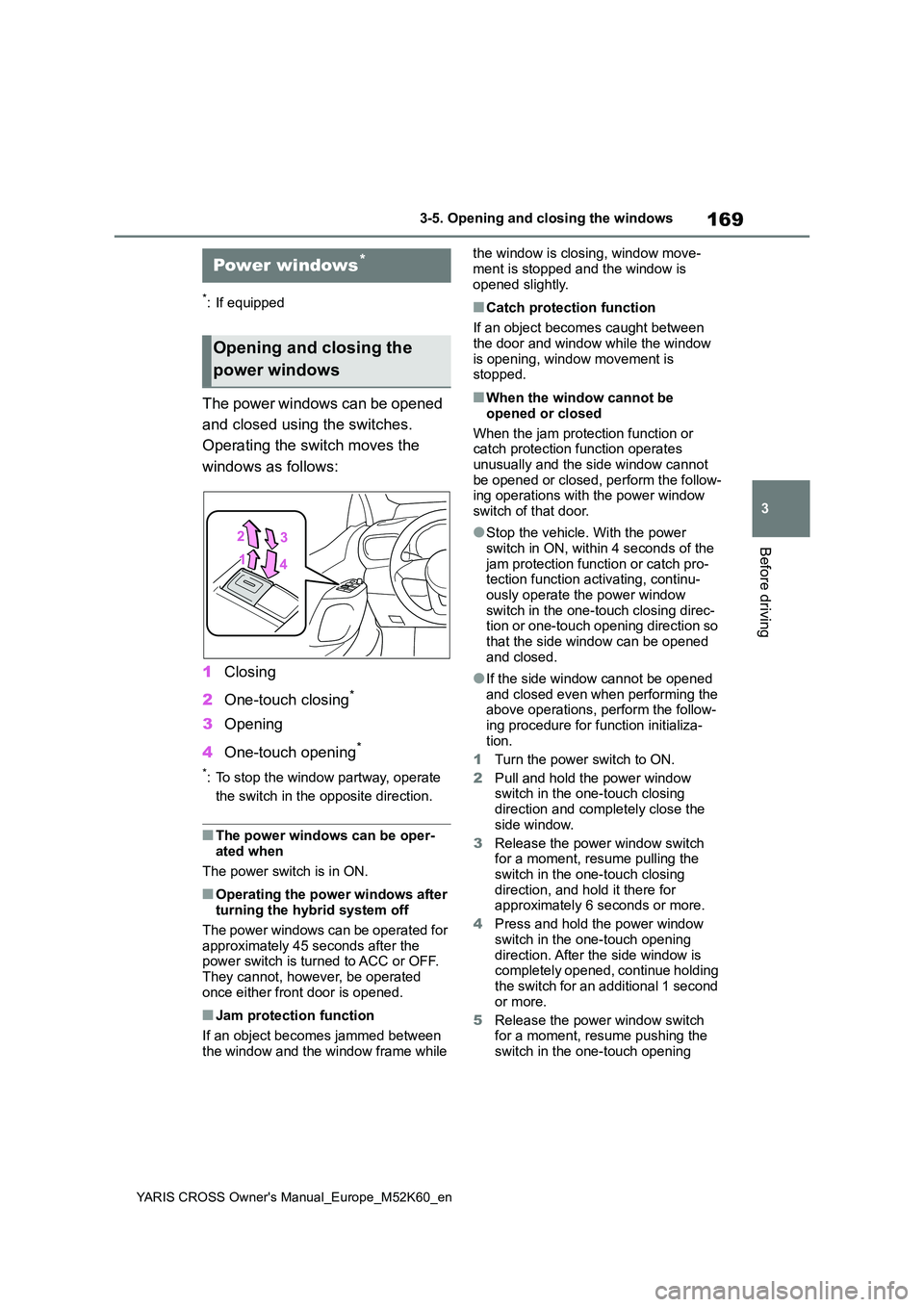
169
3
YARIS CROSS Owner's Manual_Europe_M52K60_en
3-5. Opening and closing the windows
Before driving
3-5.Opening and c los ing the win dows
*: If equipped
The power windows can be opened
and closed using the switches.
Operating the switch moves the
windows as follows:
1 Closing
2 One-touch closing*
3Opening
4 One-touch opening*
*: To stop the window partway, operate
the switch in the opposite direction.
■The power windows can be oper-
ated when
The power switch is in ON.
■Operating the power windows after turning the hybrid system off
The power windows can be operated for approximately 45 seconds after the power switch is turned to ACC or OFF.
They cannot, however, be operated once either front door is opened.
■Jam protection function
If an object becomes jammed between
the window and the window frame while
the window is closing, window move-
ment is stopped and the window is opened slightly.
■Catch protection function
If an object becomes caught between
the door and window while the window is opening, window movement is stopped.
■When the window cannot be
opened or closed
When the jam protection function or catch protection function operates
unusually and the side window cannot be opened or closed, perform the follow-ing operations with the power window
switch of that door.
●Stop the vehicle. With the power
switch in ON, within 4 seconds of the jam protection function or catch pro-tection function activating, continu-
ously operate the power window switch in the one-touch closing direc-tion or one-touch opening direction so
that the side window can be opened and closed.
●If the side window cannot be opened and closed even when performing the above operations, perform the follow-
ing procedure for function initializa- tion.
1 Turn the power switch to ON.
2 Pull and hold the power window switch in the one-touch closing
direction and completely close the side window.
3 Release the power window switch for a moment, resume pulling the
switch in the one-touch closing direction, and hold it there for approximately 6 seconds or more.
4 Press and hold the power window
switch in the one-touch opening direction. After the side window is completely opened, continue holding
the switch for an additional 1 second or more.
5 Release the power window switch for a moment, resume pushing the
switch in the one-touch opening
Power windows*
Opening and closing the
power windows
Page 175 of 650

4
173
YARIS CROSS Owner's Manual_Europe_M52K60_en
4
Driving
Driving
4-1. Before driving
Driving the vehicle ............ 175
Cargo and luggage ........... 181
Trailer towing .................... 183
4-2. Driving procedures
Power (ignition) switch (vehi-
cles without a smart entry &
start system) ................... 189
Power (ignition) switch (vehi-
cles with a smart entry & start
system) ........................... 191
EV drive mode .................. 195
Hybrid transmission .......... 197
Turn signal lever ............... 200
Parking brake ................... 200
Brake Hold ........................ 203
4-3. Operating the lights and wip-
ers
Headlight switch ............... 206
AHS (Adaptive High-beam
System) .......................... 211
AHB (Automatic High Beam)
....................................... 215
Fog light switch ................. 218
Windshield wipers and washer
....................................... 219
Rear window wiper and washer
....................................... 222
4-4. Refueling
Opening the fuel tank cap. 224
4-5. Using the driving support
systems
Toyota Safety Sense ......... 226
PCS (Pre-Collision System)
........................................ 231
LTA (Lane Tracing Assist) . 242
Dynamic radar cruise control
with full-speed range ...... 252
Speed limiter ..................... 264
RSA (Road Sign Assist) .... 266
BSM (Blind Spot Monitor) . 270
Toyota parking assist-sensor
........................................ 275
RCTA (Rear Crossing Traffic
Alert) ............................... 285
PKSB (Parking Support Brake)
........................................ 291
Parking Support Brake function
(static objects) ................ 296
Parking Support Brake function
(rear-crossing vehicles) .. 299
Toyota Teammate Advanced
Park ................................ 301
Driving mode select switch 330
Trail Mode (AWD vehicles) 331
Snow mode (AWD vehicles)
........................................ 332
Downhill assist control system
(AWD vehicles) ............... 333
GPF (Gasoline Particulate Fil-
ter) system ...................... 335
Driving assist systems ...... 336
Page 180 of 650

178
YARIS CROSS Owner's Manual_Europe_M52K60_en
4-1. Before driving
WARNING
■When shifting the shift lever
●Do not let the vehicle roll backward
while a forward driving position is selected, or roll forward while the shift lever is in R.
Doing so may result in an accident or damage to the vehicle.
●Do not shift the shift lever to P while the vehicle is moving.Doing so can damage the transmis-
sion and may result in a loss of vehicle control.
●Do no t sh i ft t h e sh if t l e ve r t o R whi l e the vehicle is moving forward.Doing so can damage the transmis-
sion and may result in a loss of vehicle control.
●Do not shift the shift lever to a driv-ing position while the vehicle is moving backward.
Doing so can damage the transmis- sion and may result in a loss of vehicle control.
●Moving the shift lever to N while the vehicle is moving will disengage the
hybrid system. Engine braking is not available with the hybrid system disengaged.
●Be careful not to shift the shift lever with the accelerator pedal
depressed. Shifting the shift lever to any positions other than P or N may lead to unexpected rapid accelera-
tion of the vehicle that may cause an accident and result in death or serious injury.
■If you hear a squealing or scrap-ing noise (brake pad wear indica-
tors)
Have the brake pads checked and replaced by any authorized Toyota
retailer or Toyota authorized repairer, or any reliable repairer as soon as possible.
Rotor damage may result if the pads are not replaced when needed.
It is dangerous to drive the vehicle when the wear limits of the brake pads and/or those of the brake discs
are exceeded.
■When the vehicle is stopped
●Do not depress the accelerator pedal unnecessarily.If the shift lever is any position other
than P or N, the vehicle may accel- erate suddenly and unexpectedly, causing an accident.
●In order to prevent accidents due to the vehicle rolling away, always
keep depressing the brake pedal while stopped with the “READY” indicator is illuminated, and apply
the parking brake as necessary.
●If the vehicle is stopped on an
incline, in order to prevent acci- dents caused by the vehicle rolling forward or backward, always
depress the brake pedal and securely apply the parking brake as needed.
●Avoid revving or racing the engine.Running the engine at high speed
while the vehicle is stopped may cause the exhaust system to over-heat, which could result in a fire if
combustible material is nearby.
■When the vehicle is parked
●Do not leave glasses, cigarette lighters, spray cans, or soft drink cans in the vehicle when it is in the
sun. Doing so may result in the follow-ing:
• Gas may leak from a cigarette lighter or spray can, and may lead
to a fire.
• The temperature inside the vehicle
may cause the plastic lenses and plastic material of glasses to deform or crack.
Page 185 of 650
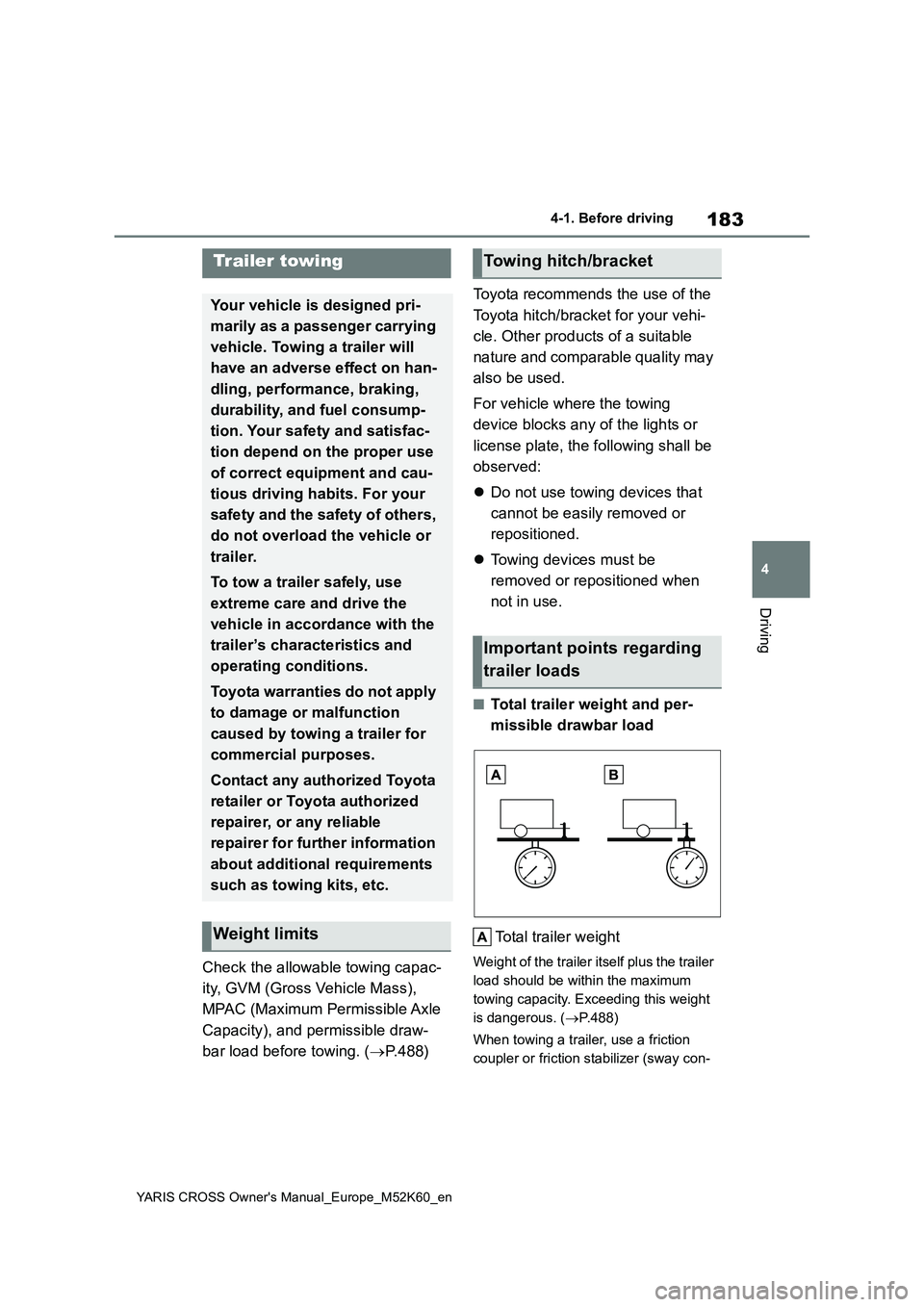
183
4
YARIS CROSS Owner's Manual_Europe_M52K60_en
4-1. Before driving
Driving
Check the allowable towing capac-
ity, GVM (Gross Vehicle Mass),
MPAC (Maximum Permissible Axle
Capacity), and permissible draw-
bar load before towing. ( P. 4 8 8 )
Toyota recommends the use of the
Toyota hitch/bracket for your vehi-
cle. Other products of a suitable
nature and comparable quality may
also be used.
For vehicle where the towing
device blocks any of the lights or
license plate, the following shall be
observed:
Do not use towing devices that
cannot be easily removed or
repositioned.
Towing devices must be
removed or repositioned when
not in use.
■Total trailer weight and per-
missible drawbar load
Total trailer weight
Weight of the trailer itself plus the trailer
load should be within the maximum
towing capacity. Exceeding this weight
is dangerous. ( P.488)
When towing a trailer, use a friction
coupler or friction stabilizer (sway con-
Trailer towing
Your vehicle is designed pri-
marily as a passenger carrying
vehicle. Towing a trailer will
have an adverse effect on han-
dling, performance, braking,
durability, and fuel consump-
tion. Your safety and satisfac-
tion depend on the proper use
of correct equipment and cau-
tious driving habits. For your
safety and the safety of others,
do not overload the vehicle or
trailer.
To tow a trailer safely, use
extreme care and drive the
vehicle in accordance with the
trailer’s characteristics and
operating conditions.
Toyota warranties do not apply
to damage or malfunction
caused by towing a trailer for
commercial purposes.
Contact any authorized Toyota
retailer or Toyota authorized
repairer, or any reliable
repairer for further information
about additional requirements
such as towing kits, etc.
Weight limits
Towing hitch/bracket
Important points regarding
trailer loads
Page 187 of 650
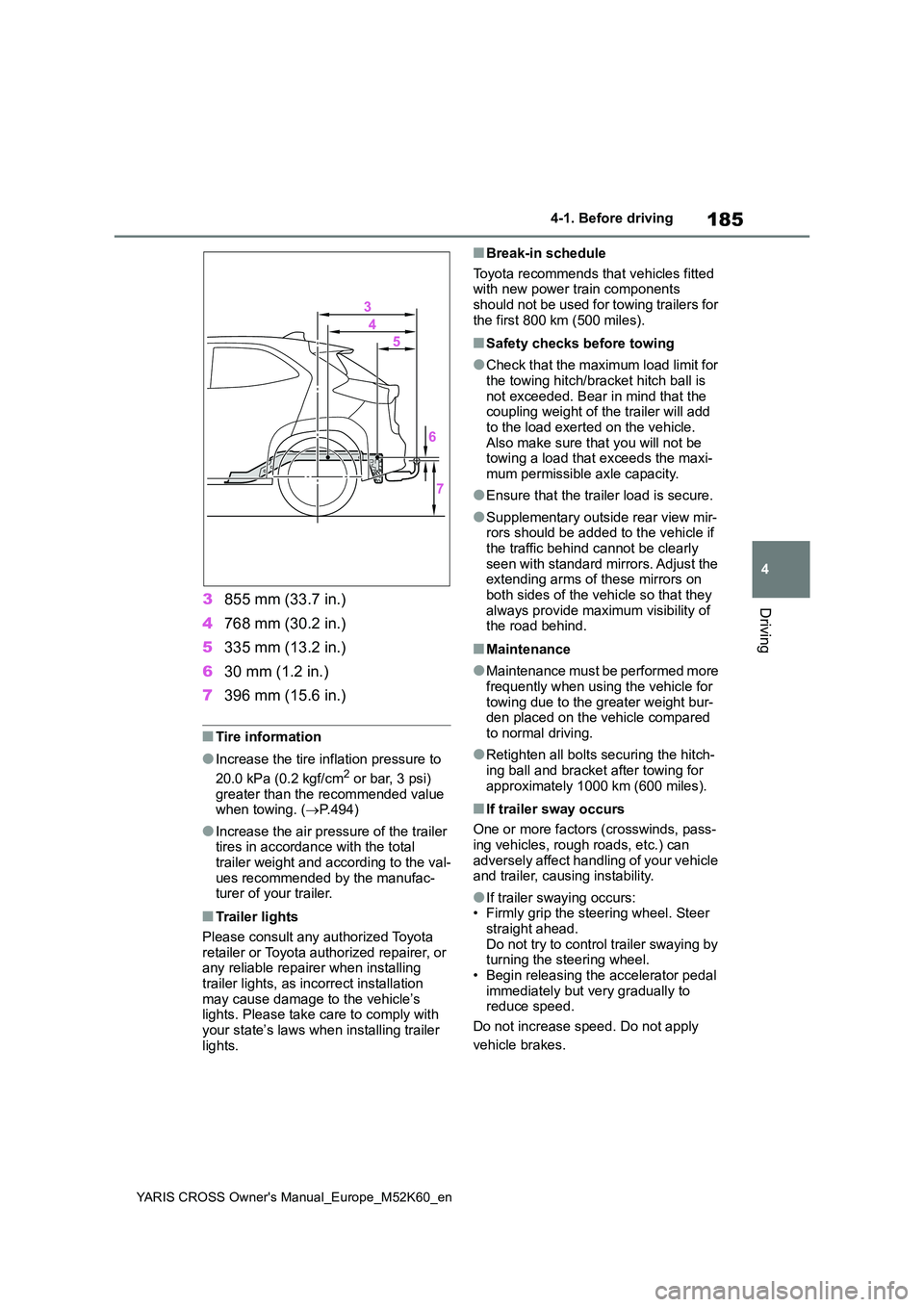
185
4
YARIS CROSS Owner's Manual_Europe_M52K60_en
4-1. Before driving
Driving3855 mm (33.7 in.)
4 768 mm (30.2 in.)
5 335 mm (13.2 in.)
6 30 mm (1.2 in.)
7 396 mm (15.6 in.)
■Tire information
●Increase the tire inflation pressure to
20.0 kPa (0.2 kgf/cm2 or bar, 3 psi) greater than the recommended value when towing. ( P.494)
●Increase the air pressure of the trailer tires in accordance with the total
trailer weight and according to the val- ues recommended by the manufac-turer of your trailer.
■Trailer lights
Please consult any authorized Toyota retailer or Toyota authorized repairer, or any reliable repairer when installing
trailer lights, as incorrect installation may cause damage to the vehicle’s lights. Please take care to comply with
your state’s laws when installing trailer lights.
■Break-in schedule
Toyota recommends that vehicles fitted with new power train components should not be used for towing trailers for
the first 800 km (500 miles).
■Safety checks before towing
●Check that the maximum load limit for
the towing hitch/bracket hitch ball is not exceeded. Bear in mind that the coupling weight of the trailer will add
to the load exerted on the vehicle. Also make sure that you will not be towing a load that exceeds the maxi-
mum permissible axle capacity.
●Ensure that the trailer load is secure.
●Supplementary outside rear view mir- rors should be added to the vehicle if
the traffic behind cannot be clearly seen with standard mirrors. Adjust the extending arms of these mirrors on
both sides of the vehicle so that they always provide maximum visibility of the road behind.
■Maintenance
●Maintenance must be performed more frequently when using the vehicle for
towing due to the greater weight bur- den placed on the vehicle compared to normal driving.
●Retighten all bolts securing the hitch-ing ball and bracket after towing for
approximately 1000 km (600 miles).
■If trailer sway occurs
One or more factors (crosswinds, pass- ing vehicles, rough roads, etc.) can
adversely affect handling of your vehicle and trailer, causing instability.
●If trailer swaying occurs:• Firmly grip the steering wheel. Steer straight ahead.
Do not try to control trailer swaying by turning the steering wheel.• Begin releasing the accelerator pedal
immediately but very gradually to reduce speed.
Do not increase speed. Do not apply
vehicle brakes.
Page 188 of 650
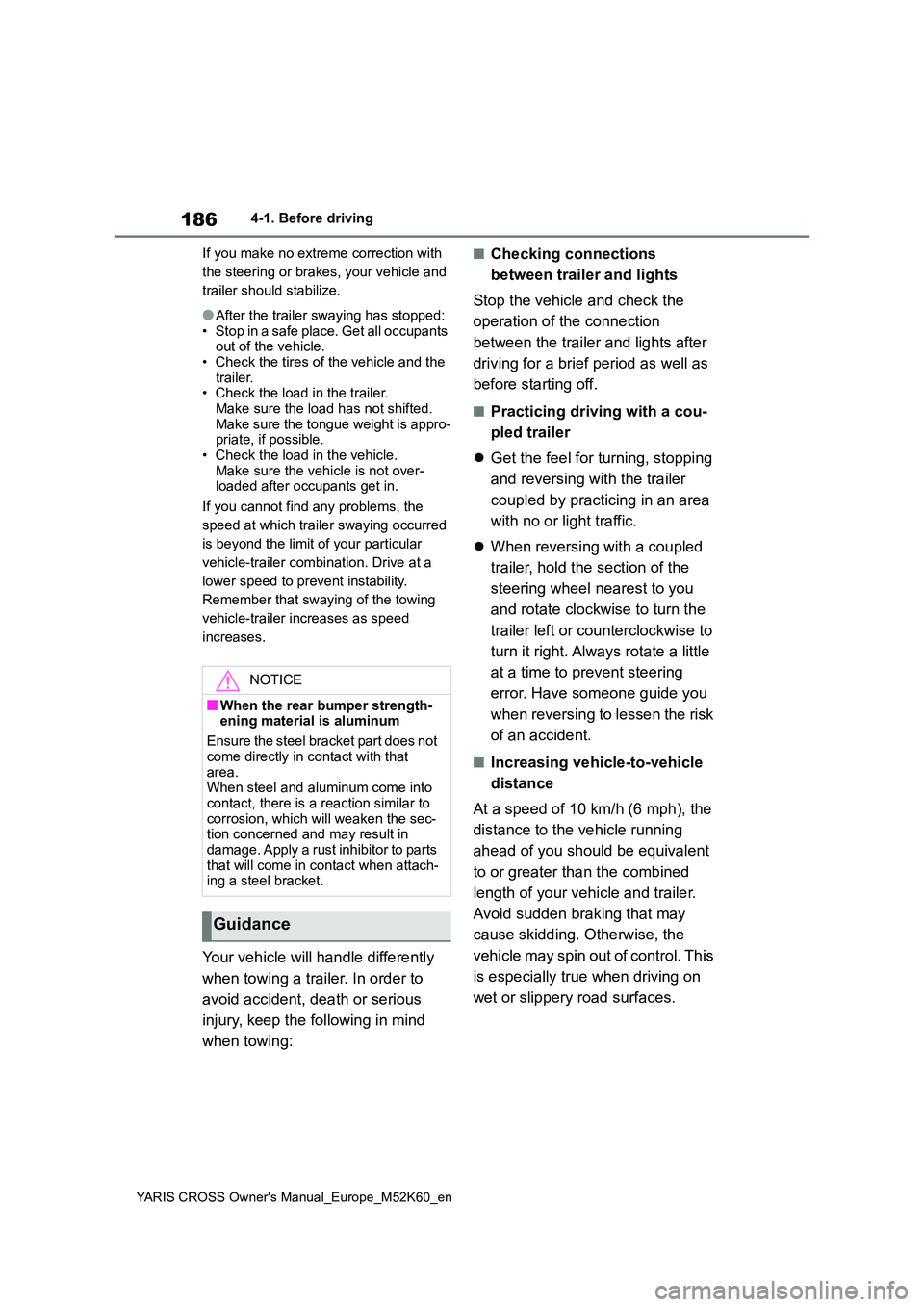
186
YARIS CROSS Owner's Manual_Europe_M52K60_en
4-1. Before driving
If you make no extreme correction with
the steering or brakes, your vehicle and
trailer should stabilize.
●After the trailer swaying has stopped: • Stop in a safe place. Get all occupants out of the vehicle.
• Check the tires of the vehicle and the trailer.• Check the load in the trailer.
Make sure the load has not shifted. Make sure the tongue weight is appro-priate, if possible.
• Check the load in the vehicle. Make sure the vehicle is not over-loaded after occupants get in.
If you cannot find any problems, the
speed at which trailer swaying occurred
is beyond the limit of your particular
vehicle-trailer combination. Drive at a
lower speed to prevent instability.
Remember that swaying of the towing
vehicle-trailer increases as speed
increases.
Your vehicle will handle differently
when towing a trailer. In order to
avoid accident, death or serious
injury, keep the following in mind
when towing:
■Checking connections
between trailer and lights
Stop the vehicle and check the
operation of the connection
between the trailer and lights after
driving for a brief period as well as
before starting off.
■Practicing driving with a cou-
pled trailer
Get the feel for turning, stopping
and reversing with the trailer
coupled by practicing in an area
with no or light traffic.
When reversing with a coupled
trailer, hold the section of the
steering wheel nearest to you
and rotate clockwise to turn the
trailer left or counterclockwise to
turn it right. Always rotate a little
at a time to prevent steering
error. Have someone guide you
when reversing to lessen the risk
of an accident.
■Increasing vehicle-to-vehicle
distance
At a speed of 10 km/h (6 mph), the
distance to the vehicle running
ahead of you should be equivalent
to or greater than the combined
length of your vehicle and trailer.
Avoid sudden braking that may
cause skidding. Otherwise, the
vehicle may spin out of control. This
is especially true when driving on
wet or slippery road surfaces.
NOTICE
■When the rear bumper strength- ening material is aluminum
Ensure the steel bracket part does not
come directly in contact with that area.When steel and aluminum come into
contact, there is a reaction similar to corrosion, which will weaken the sec-tion concerned and may result in
damage. Apply a rust inhibitor to parts that will come in contact when attach-ing a steel bracket.
Guidance
Page 190 of 650
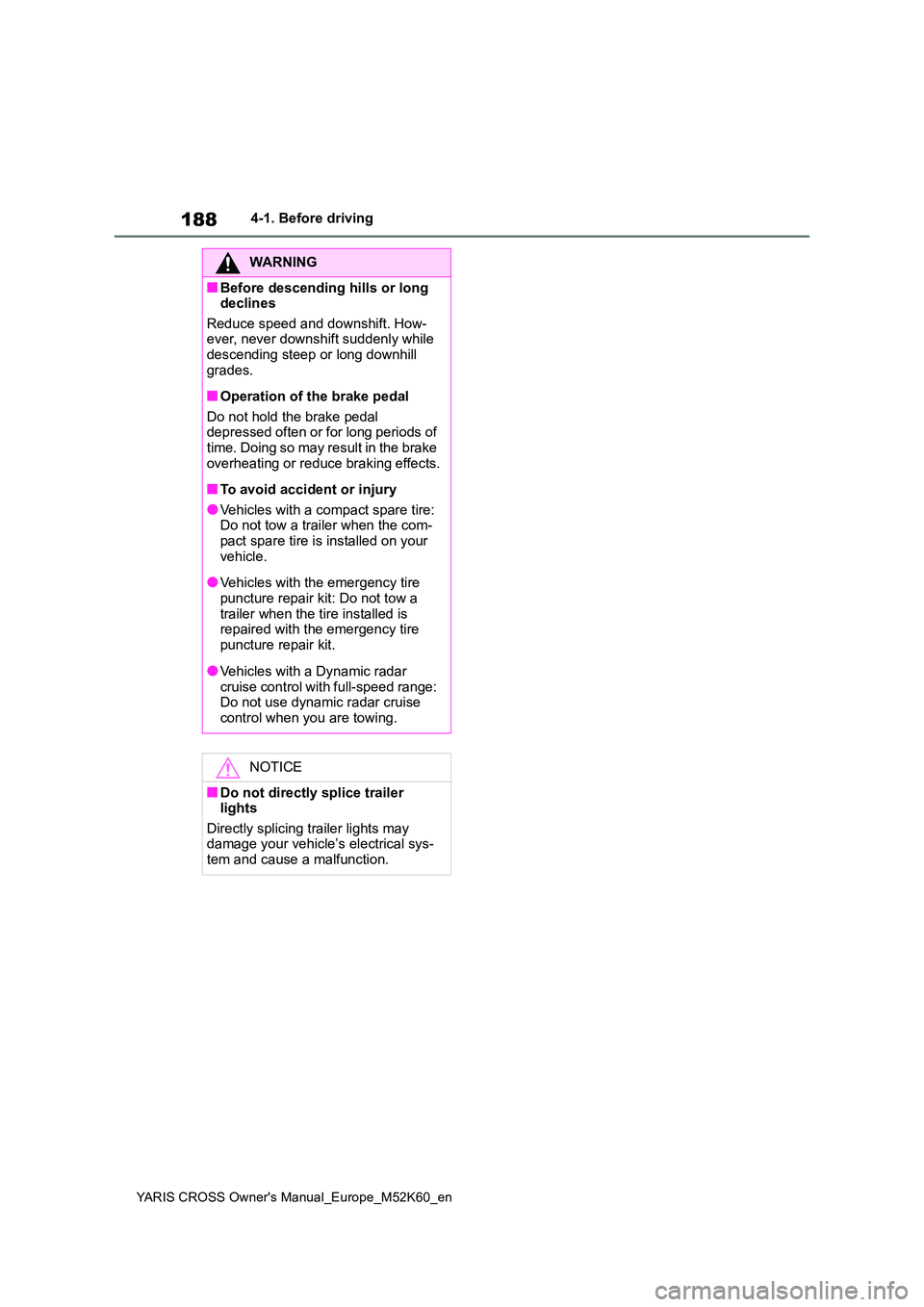
188
YARIS CROSS Owner's Manual_Europe_M52K60_en
4-1. Before driving
WARNING
■Before descending hills or long declines
Reduce speed and downshift. How- ever, never downshift suddenly while descending steep or long downhill
grades.
■Operation of the brake pedal
Do not hold the brake pedal depressed often or for long periods of time. Doing so may result in the brake
overheating or reduce braking effects.
■To avoid accident or injury
●Vehicles with a compact spare tire: Do not tow a trailer when the com-pact spare tire is installed on your
vehicle.
●Vehicles with the emergency tire
puncture repair kit: Do not tow a trailer when the tire installed is repaired with the emergency tire
puncture repair kit.
●Vehicles with a Dynamic radar
cruise control with full-speed range: Do not use dynamic radar cruise control when you are towing.
NOTICE
■Do not directly splice trailer lights
Directly splicing trailer lights may damage your vehicle’s electrical sys-tem and cause a malfunction.